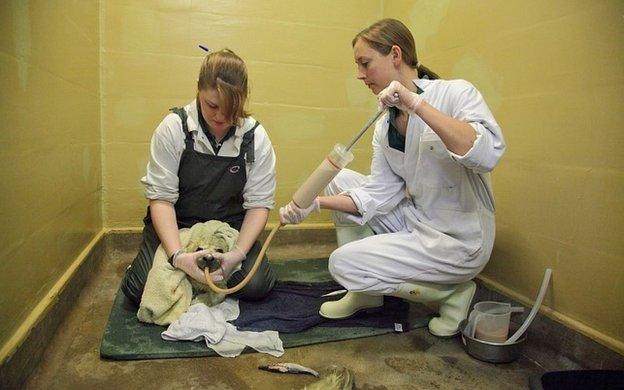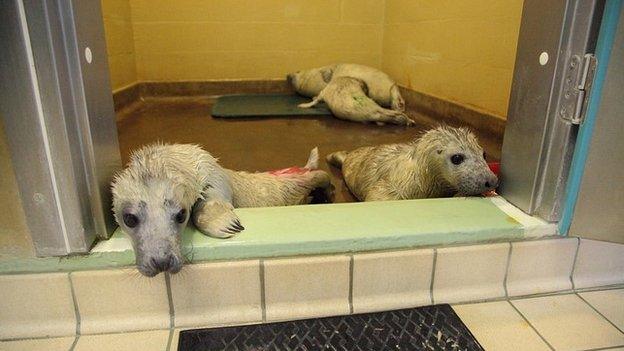Key wildlife sites hit in flooding
- Published
- comments
David Shukman reports on the impact recent storms have had on UK wildlife
Nearly 50 of Britain's special wildlife sites were hit in the "devastating" recent flooding, according to a new assessment.
Initial surveys have revealed how storms and surges breached embankments and wrecked pumping machinery.
Otters and seal pups were among the animals caught by the inundations and there are long-term fears for the loss of coastal habitats.
Alastair Driver, head of biodiversity of the Environment Agency, told the BBC that the scale of the damage was "potentially very serious".
"This is worse than anything we've ever seen before. This impact of this tidal surge was the highest ever recorded in many parts and the impact to these wildlife sites is in many cases devastating."
The tidal surge that hit the east coast of England on 5 and 6 December was particularly damaging and even now the full scale of its impact is not understood.
The report was drawn up by Natural England with help from the Environment Agency and other bodies.
It concludes that "at least 48" Sites of Special Scientific Interest (SSSIs) in England have been affected - and that 37 of them are of international importance.
Its author, Tim Collins of Natural England, told me the floods would "drive a number of significant changes to coastal conservation sites with multiple breaches making it illogical to try to retain the status quo".
He also warned that the total number of wildlife sites affected is likely to rise in the wake of the most recent storms.
At the maximum extent of the flooding, 4,500 hectares of designated coastal reserves were under water.
Initial reports said as many as 170 seal pups may have been swept away from colonies on the north Norfolk coast but later surveys suggest that fewer were lost.
One of the greatest concerns is for the future of rare freshwater habitats close to the coast - multiple breaches in the sea defences allowed saltwater to pour through, swamping ecosystems that rely on freshwater.
Mr Driver said the floods caused not only immediate damage but also a long-lasting effect through the rise in salinity.

The East Winch Wildlife Centre is caring for injured seal pups caught up in December's tidal surge
"The initial damage when the sea comes piling in is often physical and in fact in some cases birds are actually drowned because they could not fly away in extreme winds and high waves.
"But it's more a case of the long-term damage - when you get breaches, the sea is coming in on every spring tide. It's going to be flooding on a regular basis and changing the salinity for ever."
Mr Driver was speaking at the site of a wrecked defensive embankment at Blakeney on the north Norfolk coast. The tidal surge had overtopped the bank and gouged out dozens of massive gaps in one half-mile stretch alone.
Laurence Rose of the RSPB said several of the organisation's sites had suffered damage to infrastructure and that the long-term effects were still unclear.
"It'll take us a while to know exactly how bad it's been but there are insects and freshwater fish and the building blocks of the freshwater food chain which could be devastated," he said.
"Generally you'd expect freshwater habitats that have been filled with seawater to be in a really bad way.

Many of the young pups are less than three weeks old
"You've got otters along here, you've get rare birds like the bittern which is a fish eating bird and you've got all the waders and herons which all depend on the smaller creatures - the frogs and the insects and the like.
"So it's not just about losing some invisible insects but potentially losing the base of a pyramid that includes all the other species as well."
The hope is that the natural resilience of many species will aid recovery - or that there are isolated pockets where freshwater species have survived and can begin the process of recovery.
As Mr Rose put it: "Nature has way of bouncing back but we won't know if it can do that for some time to come."
The damage to defences is on such a massive scale that the Environment Agency and other bodies face difficult questions about whether repairs can be justified.
The priorities in spending on flood protection are to save lives and property - and wildlife officials stress that they fully support that.
But in some cases freshwater nature reserves are designated under European legislation - meaning the authorities have an obligation to maintain them.
In others, allowing the sea to flow into freshwater reed-beds may be the most logical option, avoiding costly repairs and using salt marshes to provide a natural buffer against storms.
Another factor is that wildlife reserves are a major tourist attraction in areas such as north Norfolk with bird-watching enthusiasts contributing significantly to regional income.
With government funding under pressure, the issue of which defences to repair and which to abandon has become highly contentious.
Councillor Marie Strong, who represents many coastal districts on Norfolk County Council, says wildlife should not be forgotten as defences are repaired or extended but that it should not be the first priority.
"The first thing has got to be homes and people and businesses because that's people's livelihoods - it's not just saying that shop's got to be kept going because that has a knock-on effect on people's lives," she says.
"But of course so does the wildlife, particularly around here - that does have an effect on tourism so that has to follow but it does need to follow.
"If the people are drowned, they're not going to be enjoying the wildlife and if their homes are destroyed they won't be here and if the hotels and bed and breakfasts aren't here you're not going to get other people to enjoy the wildlife.
"But I'm not saying wildlife is unimportant because it's very much part of this coast."
Studies in the next few months will reveal exactly what damage the flooding has caused - and the choices that lie ahead.